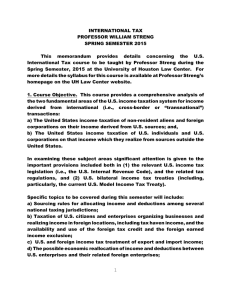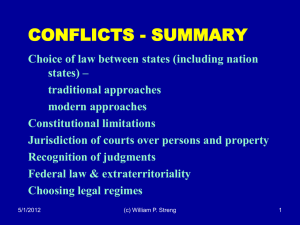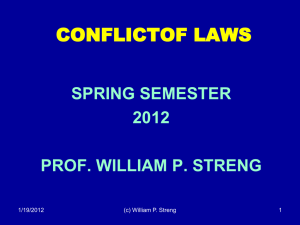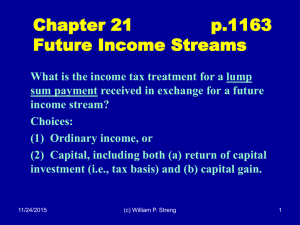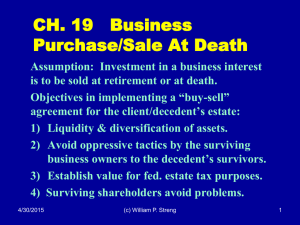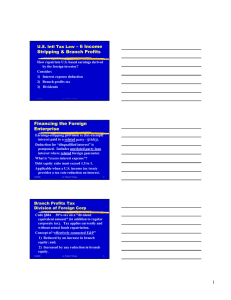Chapter 12 - Exploiting Intangibles Outside U.S.
advertisement
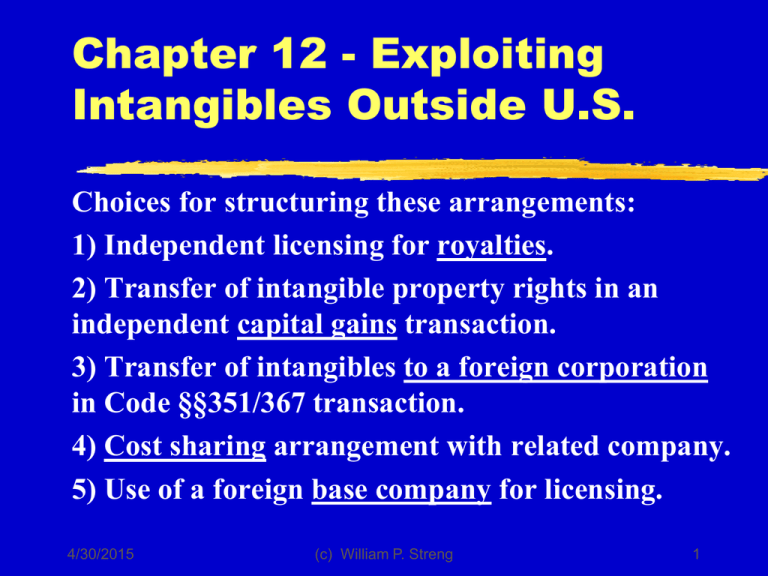
Chapter 12 - Exploiting Intangibles Outside U.S. Choices for structuring these arrangements: 1) Independent licensing for royalties. 2) Transfer of intangible property rights in an independent capital gains transaction. 3) Transfer of intangibles to a foreign corporation in Code §§351/367 transaction. 4) Cost sharing arrangement with related company. 5) Use of a foreign base company for licensing. 4/30/2015 (c) William P. Streng 1 Definition of Intangibles p.967 1) Patents, inventions, know-how. 2) Copyrights. 3) Trademarks, tradenames. 4) Franchises, licenses, contracts. 5) Methods, programs, systems, procedures, customer lists, etc. 6) Other similar items. Reg. §1.482-4(b) & Code §936(h)(3)(B). 4/30/2015 (c) William P. Streng 2 Licensing Intangibles to an Independent for Royalties Basics: 1) International licensing enables royalties without a significant foreign investment. 2) Limited foreign country tax usually incurred on an outbound royalty payment. 3) Planning: Use royalties from unrelated licensees in a licensing trade or business to enhance the amount in the general limitation FTC basket. See Code §904(d)(1)(B) (i.e., assumes that royalties are not in the passive income basket). 4/30/2015 (c) William P. Streng 3 Tax Incentives for Licensing Intangibles P.968 Use no/low taxed royalties in a foreign country to average down the foreign tax cost for purposes of being below the overall FTC limitation amount. Do royalties paid enable an income tax deduction to the payor in the payor’s country? This assumes the royalties will enable classification within the general limitation FTC basket (under look-through rules). 4/30/2015 (c) William P. Streng 4 Tax Treatment of Royalties in Source Country p.969 Royalty payments are tax deductible in the licensee/payor's country (?). Transfer pricing considerations apply in the payor's country under (i) the payor country's tax law, or (ii) an applicable bilateral tax treaty. Licensor's tax treatment in source country? 1) Treaty - exemption or low withholding tax rate. 2) Statutory tax rules – possible tax withholding at source. 4/30/2015 (c) William P. Streng 5 U.S. Income Tax Treatment of Royalty Income p.970 For foreign tax credit purposes, are royalties received in the active conduct of a trade or business? If so, then FTC general limitation basket income: §904(d)(1)(B). Possible to absorb excess foreign tax credits. Otherwise, §904(d)(1)(A) passive basket income. Therefore, a necessity for exploiting inventions generated through the entity’s own research and development - to qualify for the active-business test. 4/30/2015 (c) William P. Streng 6 Problem U.S. Corp’s Patents p.972 Comet regularly buys U.S. and foreign pharmaceutical patents. Technical employees are responsible for commercialization of patents. Licensing in the United States and abroad in return for royalties equal to a specified percentage of the net sales by the licensees. Source of royalties? U.S./foreign patents? Sourced to where the patent was issued. What FTC limitation basket? A or Residual B? Derived in active conduct of a trade or business? 4/30/2015 (c) William P. Streng 7 Capital Gains Licensing p.973 Transfer of “all substantial rights” as constituting a sale of (1) a capital asset, or (2) a §1231 property (even when payment as a stream of royalties). Therefore, eligibility for LTCG treatment (and the intangible asset transferred is assumed to not be inventory). Treatment under §§1221, 1231 or 1235 (to avoid ordinary income tax status). 4/30/2015 (c) William P. Streng 8 Patents p.973 & Trademarks & Goodwill Patents as (1) a capital asset (§1221), or (2) §1231 assets? §1235 - deemed sale or exchange treatment – the treatment only applicable to individuals. Patent as a monopoly grant - 20 (21?) years from date of the patent application. A federal property law concept. Possible U.S. tax amortization (§197) of the income tax basis by the purchaser of this item. 4/30/2015 (c) William P. Streng 9 Know-how p.974 Know-how is identified as “secret information” – enabling a right to prevent unauthorized disclosure; a local law property concept. Can it be a capital asset for capital gains licensing purposes? Rev. Rul. 64-56 (p.1018) - foreign country where the transferee is located must provide substantial legal protections against the unauthorized disclosure of the know-how (to enable it to be categorized as “property” for federal tax purposes). 4/30/2015 (c) William P. Streng 10 Copyrights p.976 Monopoly granted under federal law for 70+ years in the U.S. Does a foreign law comparable exist? No capital gains treatment if personal efforts of the holder created the copyrighted work. §§1221(a)(3)(A) and 1231(b)(1)(C). See Reg. §1.861-18 concerning transfers of computer programs. A copyright sale necessitates the transfer of all substantial rights. 4/30/2015 (c) William P. Streng 11 Patent “Sale” Requirement p.977 What is a “sale or exchange” of a patent? 1) Actual assignment (i.e., title transfer). 2) Exclusive “license” to use, manufacture and sell the patented invention within a defined geographical area for the remaining life of the patent. Legal title to the patent is retained by the licensor. Assignment of all substantial rights to the patent can be treated as a “sale” for U.S. income tax purposes. 4/30/2015 (c) William P. Streng 12 “Sale” Requirement, cont. Forms of Payment p.978 Possible payment options enabling LTCG treatment upon a “sale”: 1) Single fixed payment. 2) Fixed installment payments. 3) Contingent royalty payments over a specified period is permitted (useful life of the asset?) Payment for ancillary services is permitted. Retention of various controls over transferred asset are permitted. Are external standards applicable? 4/30/2015 (c) William P. Streng 13 Retained Patent Rights (sale treatment permitted) “Snap-back” provisions can be retained (where not within the transferor’s control): 1) Bankruptcy; 2) Lack of productivity and, therefore, inadequate royalties to the licensor; 3) Foreign country expropriation of the property; 4) Foreign exchange controls become applicable; 5) Veto right over sublicensing. Cf., right of licensor to sublicense others in the licensee’s territory. 4/30/2015 (c) William P. Streng 14 DuPont case p.980 Income Characterizarion Functional subdivision of foreign patent rights Funds were received in exchange for an assignment of certain Brazilian patents. Taxable as ordinary income or as capital gains? Refund claim was based on capital gains status, after reporting ordinary income. §1222 and §1231? Conclusion: division of functional applications can be acceptable to enable “sale” treatment for U.S. income tax purposes; here the value of the retained rights is problematical. 4/30/2015 (c) William P. Streng 15 Problem Independent Licensee p.985 1. Exclusive license to independent licensee. License otherwise qualifies as a sale for tax purposes. Tax effect of a right to terminate: a) After license is in effect for ten years; Not a transfer of all substantial rights, since not for 20 year life of the patent (unless only 10 years left). b) Exchange controls - beyond the control of the licensor - not vitiating sale treatment. Cont. 4/30/2015 (c) William P. Streng 16 Problem, continued c) Bankruptcy of the licensee - same as b. d) Failure to reach production levels. If the production levels are reasonably attainable, then not within the control of the licensor, and imposing this condition is not inconsistent with sale. e) Failure to use "best efforts" to develop a market. Best efforts is a subjective standard, but the licensor's judgment on this issue would not be determinative. continued 4/30/2015 (c) William P. Streng 17 Problem, continued f) Quality standards. This requirement is consistent with sale status if the quality standards are appropriate and reasonably attainable. g) Failure to supply the reasonable needs of the customers. Not preventing the qualification of the license as being a sale for U.S. tax purposes. h) Right to veto sublicensing. Veto over sublicensing is not inconsistent with a sale. 4/30/2015 (c) William P. Streng 18 Sales of “Know-how” and Trade Secrets p.986 Value of know-how is dependent upon continuing secrecy and not on existence of a govt. monopoly. DuPont case , p. 986. No “sale” here. IRS says secret process was “property” but that no “sale” occurred. Therefore, no preferential capital gains treatment & ordinary income treatment. Transfer of a trade secret may be equivalent to a sale. Must transfer the right to prevent unauthorized disclosure of the secret, but not occurring here. Must be an enforceable right under local law. 4/30/2015 (c) William P. Streng 19 Sales of Copyrights as Business Profits? p.993 A copyright can be sold – including for royalty payments (rather than for a lump sum). Computer programs – many formats for the transfer of rights (Reg. §1.861-18): 1) Copyright transfer; 2) Transfer of a copy of the computer program; 3) Services for program use; 4) Know-how concerning programming Are all “substantial rights” being transferred? 4/30/2015 (c) William P. Streng 20 Sale of Patent Rights to a Foreign Controlled Corp. P. 995. IRC §1249 provides that gain realized on a patent, etc., transfer to a foreign corporation controlled by the U.S. transferor will be treated as ordinary income and not as capital gain. Why? Relevant to individuals. IRC §1249(b) - control means ownership, directly, indirectly or constructively, of the stock of the foreign corporation possessing more than 50 percent of the total combined voting power of all voting classes of stock. 4/30/2015 (c) William P. Streng 21 Transfers of Trademarks, Tradenames & Franchises §1253 p.997 Gain on the transfer of a trademark or tradename or franchise: Ordinary income and not capital gains if the transferor retains any “significant power, right or continuing interest” with respect to the transferred property. See §1253(b)(2) providing a listing of what constitutes a "significant power, right, or continuing interest". 4/30/2015 (c) William P. Streng 22 Syncsort v. U.S. Franchise License p.998 Are computer software licenses to foreign licensees within the scope of §1253? Alternatively, are the related intangibles treated as transfers separate from franchise transfer? Holding: Franchises exist for §1253 purposes. The transfers made were of the right to sell the programs. The taxpayer retained significant rights. Ordinary income was realized. 4/30/2015 (c) William P. Streng 23 OID Issue - Sale for Stated Amount/No Interest p.1005 Installment payments for intangible sales. OID may be imputed - §1274 applies if the stated redemption price exceeds imputed principal amount. When does this occur? §1274 is inapplicable for less than $250,000 sales; but, §483 is then applicable and the result is essentially similar. §1235(a) (individual) sales or exchanges of patent rights are not subject to §1274 or §483 rules. 4/30/2015 (c) William P. Streng 24 Source of Income Rules & Intangible Property p.1006 To the residence - where a fixed price sale. §865(a) and (d)(1)(A). Including when deferred. Royalty source rule if the price is contingent on productivity. §862(a)(4). §865(d)(1)(B). Depreciation recapture rule. §865(d)(4)(B). Special sourcing rule for goodwill - source to the country in which the goodwill was generated. §865(d)(3). How is goodwill sold? 4/30/2015 (c) William P. Streng 25 Transfer of Intangibles in Exchange for Stock p.1010 1. Cost basis of intangible property transferred is probably zero - since §174 permits a current R&D deduction. 2. §351 precludes gain recognition on the transfer of appreciated assets, if applicable: - must transfer "property" - transferors must have 80% control (as a group) in the transferee corporation. Cont. 4/30/2015 (c) William P. Streng 26 §367(d) rules for intangible property transfers p.1012 Transfer of intangibles to a foreign corporation: a) no immediate income tax recognition. b) but licensing treatment, as if sold to the transferee for periodic (or contingent) payments. c) full gain recognition if intangible is sold by the foreign corporation after the transfer to the foreign corporation (or if the transferee corp. stock sold). d) treated as ordinary income (even though a deemed sale) continued 4/30/2015 (c) William P. Streng 27 §367(d), continued e) until TRA-97, also treated as U.S. source income. Now treated as foreign source. f) exception for foreign goodwill or going concern value. Foreign based residual value of the business. g) valuation problems – super-royalty provision, i.e., amount treated as received must be “commensurate with income.” P. 1014. h) Foreign corp. E&P reduction is made for the deemed royalty amount - §367(d)(2)(B) cont. 4/30/2015 (c) William P. Streng 28 §367(d), continued Other §367(d) considerations: - Use a sale/license rather than §351 for intangibles transfer into corporation? - Royalty is treated as an account receivable under §367(d). - Elect sale treatment? P. 1015. But, U.S. source ordinary income; Reg. §1.367(d)-1T(g)(2). -Transfer to a partnership – see §367(d)(3) (note the partnership tax rule in a Subchap. C §). 4/30/2015 (c) William P. Streng 29 “Property” Requirement a Code §351 Element Rev. Rul. 64-56 (p. 1018) - does “know-how” constitute “property” for §351 purposes? Or, does it constitute services (& §351 is not available)? To be “know-how” the country where the transferee operates must afford the transferor substantial legal protection against the unauthorized disclosure and use of the process, formula, or other secret information involved. See Rev. Proc. 69-19, p.1021. Note the representations to be made when seeking a tax ruling for a knowhow transfer/stock exchange. 4/30/2015 (c) William P. Streng 30 “Property” Transfer Requirement - §351 p.1022 A transfer must be made of "all substantial rights" for a property transfer to occur for §351 purposes (& not only partial rights, i.e., a license). Ordinarily, the transfer of economic rights for intangibles is accomplished by an exclusive license, rather than by a legal assignment. Retention of certain controls and rights of recapture may be acceptable for this purpose. 4/30/2015 (c) William P. Streng 31 Dupont case p.1023 Non-Exclusive License Royalty-free non-exclusive license (under French patent) to sub to make, use & sell item in France. Parent received stock as a result of this license. Challenge re §351 & holding that § 351 not having the same concepts as the capital gains provisions. Capital gains contemplate completeness of disposition, but §351 is based on control over the transferred rights. Held: Non-exclusive license to the subsidiary was a § 351 “property” transfer. 4/30/2015 (c) William P. Streng 32 Transfer as a “Contribution to Capital” p.1029 §367(c)(2) - contribution to corporation is treated as a constructive exchange for §367 purposes. If the transfer is made of an appreciated “intangible” - then this transfer is subject to the further provisions of §367(d). 4/30/2015 (c) William P. Streng 33 Base Company Licensing & Headquarters Entity p.1030 Possible to get larger after-foreign tax profits in an offshore licensing company (when compared to payments directly into the United States)? Royalty paid is (ordinarily) permitted as a deduction for foreign country payor tax purposes. Generate low/no taxed royalty income to blend with high taxed income (assuming general limitation basket income). 4/30/2015 (c) William P. Streng 34 Applicability of Subpart F Rules – Deferral Available? P. 1033. Impact of Subpart F - not applicable if: i) Related party/same country exception is available. §954(c)(3)(A), or ii) Another exception is available when royalties are derived in the “active conduct of a trade or business” and received from a non-related person. §954(c)(2)(A). 4/30/2015 (c) William P. Streng 35 Arm’s Length Pricing Requirement p.1038 Code §482 requires an arm’s length pricing treatment for transfers of intangibles as applying to: 1) licenses, 2) sales, and 3) contribution to transferee’s capital (with or without stock being received in the exchange). This includes the “commensurate with income” mandate. Note the FY 2016 Obama proposals in this context. 4/30/2015 (c) William P. Streng 36 Alternative Arm’s Length Pricing Approaches p.1040 Reg. §1.482-4(a). 1) comparable uncontrolled transaction(CUT) 2) comparable profit method (CPM) 3) profit split methods (PSM). Subject to applicability of the “best method” approach. Reg. §1.482-1(c). Subject to periodic adjustments. Alternative: possible cost-sharing agreement. 4/30/2015 (c) William P. Streng 37 Problem p.1049 Drug B license with an independent as a comparable uncontrolled transaction (CUT) for the controlled licenses of drugs A and C? Relevant criteria: 1) patented? 2) representing significant improvements; 3) expected to promptly reach high sales levels; 4) anticipated same average annual profits. 4/30/2015 (c) William P. Streng 38 Cost Sharing Arrangements Reg. §1.482-7 p.1050 Sharing by multiple parties of the costs and the risks for developing intangible property in return for a property interest in that intangible. Must have a method to calculate each controlled participant's share of the intangible development costs - based on the anticipated benefits to be received. Cost sharing arrangement components – see p. 1056. 4/30/2015 (c) William P. Streng 39 Buy-In and Buy-Out Arrangements p.1061 What is a buy-in or buy-out arrangement? Reg. §1.482-7(g). Compensation must be provided for the contributor of any excess value in the cost-sharing arrangement. 4/30/2015 (c) William P. Streng 40 Advance Pricing Agreements p.1071 Possible for IRS and taxpayer to negotiate and agree on the specific future resolution of pricing issues for intangible (and other) transfers to a related party (particularly a related foreign corporation). See the Chapter 8 material. 4/30/2015 (c) William P. Streng 41
